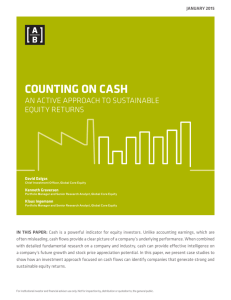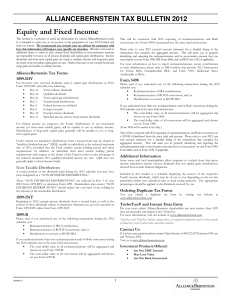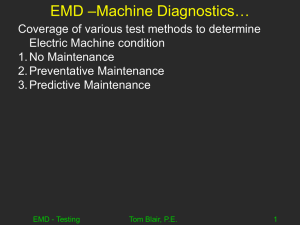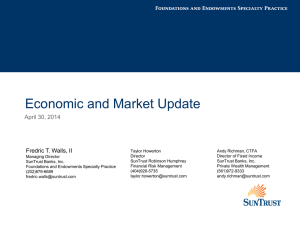Dec 2012
advertisement
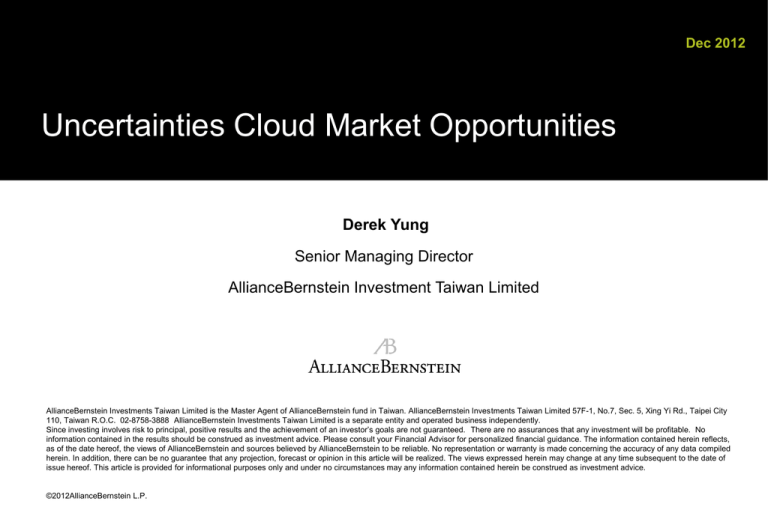
Dec 2012 Uncertainties Cloud Market Opportunities Derek Yung Senior Managing Director AllianceBernstein Investment Taiwan Limited AllianceBernstein Investments Taiwan Limited is the Master Agent of AllianceBernstein fund in Taiwan. AllianceBernstein Investments Taiwan Limited 57F-1, No.7, Sec. 5, Xing Yi Rd., Taipei City 110, Taiwan R.O.C. 02-8758-3888 AllianceBernstein Investments Taiwan Limited is a separate entity and operated business independently. Since investing involves risk to principal, positive results and the achievement of an investor’s goals are not guaranteed. There are no assurances that any investment will be profitable. No information contained in the results should be construed as investment advice. Please consult your Financial Advisor for personalized financial guidance. The information contained herein reflects, as of the date hereof, the views of AllianceBernstein and sources believed by AllianceBernstein to be reliable. No representation or warranty is made concerning the accuracy of any data compiled herein. In addition, there can be no guarantee that any projection, forecast or opinion in this article will be realized. The views expressed herein may change at any time subsequent to the date of issue hereof. This article is provided for informational purposes only and under no circumstances may any information contained herein be construed as investment advice. ©2012AllianceBernstein L.P. Markets Performed Better than They Felt… Returns in US Dollars 3Q 2012 Returns YTD 2012 Returns 28 Feb 2009 – 30 Sep 2012 Annualized Returns World US Europe Equities Japan Emerging Markets Global High Yield Credit Emerging Market Debt Global Corp Gov’t Bonds US Gov’t Japan Gov’t Euro Gov’t Commodities Alternatives Treasury Inflation Protected Securities Global Real Estate Investment Trusts Past performance does not guarantee future results. As of 30 September 2012 Global High Yield, Global Corp, Japan Gov’t and Euro Gov’t in hedged USD terms. All other non-US returns in unhedged USD terms. An investor cannot invest directly in an index and its performance does not reflect the performance of any AllianceBernstein portfolio. The unmanaged index does not reflect fees and expenses associated with the active management of a portfolio. Please see the end of the presentation for index definitions. Source: Barclays Capital, DJ-UBS, FactSet, FTSE, MSCI, Standard & Poor’s and AllianceBernstein AllianceBernstein.com 1 …Because of Real Economic and Capital-Market Uncertainties… BUSINESS ‘Fiscal Cliff’ Becomes Top Investor Concern for September BofA: September 18, 2012 Greek Leaders Struggle With Spending Reductions September 20, 2012 Spain, Italy 10-Year Bonds Drop; Spanish Yield Rises to 6.46% Italy slashes growth forecast for 2012. Rome expects 2.4% contraction August 28, 2012 while eurozone PMI falls. September 19, 2012 August 5, 2012 Fearing an Impasse in Congress, Industry Cuts Spending WORLD September 10, 2012 Asia Trade Data Show Weakening Demand AllianceBernstein.com China, euro-zone PMI data highlight global fears September 20, 2012 US inflation fears rise after QE3 September 17, 2012 2 We Expect Modest Global Growth to Continue Global Purchasing Managers’ Index (PMI) Tension between uncertainties’ cumulative effect on global growth… Official Rates (Percent) Emerging Markets …and highly stimulative fiscal and monetary policies… Developed Markets AllianceBernstein Real GDP Growth Forecasts (Percent) …should culminate in a slightly better 2013 PMI through August 31, 2012; official rates and GDP forecasts as of September 30, 2012 Source: JPMorgan Chase, Markit and AllianceBernstein AllianceBernstein.com 3 Attractive Equity Potential Tempered by Volatility Long-Term Expected Return (%) Near-Term Expected Global Equity Volatility (%) Asset Allocation Our View of Equity Allocation: Long-Term 60/40 Investors Long-Term Average 70 15.5 14.6 60 50 Global Stock Index Equity Allocation (%) Normal 40 Historical analysis and current forecasts do not guarantee future results. Data do not represent past performance and are not a promise of actual results or range of future results. As of 1 October 2012 Global sovereign bonds are represented by global, developed, sovereign, seven-year constant-maturity nominal bonds; global stocks by a universe similar to MSCI World. Both are reported in and hedged into US dollars. *As of 30 September 2012. Equity here refers to 70% US equity (MSCI USA) and 30% international equity (25% MSCI EAFE, 5% MSCI EM). **Represented by the MSCI All Country World Index. An investor cannot invest directly in an index and its performance does not reflect the performance of any AllianceBernstein portfolio. The unmanaged index does not reflect fees and expenses associated with the active management of a portfolio. Please see end of presentation for index definition. Source: MSCI and AllianceBernstein AllianceBernstein.com 4 Market Environments Inform Portfolio Strategy Potential Market Environments and Portfolio Strategies Financial Crisis/Recession Negative real growth Fears of deflation Risk On/Risk Off 1%–2% global GDP growth Fears shift between inflation and deflation Recovery/Normalization Market Volatility High and sustained Frequent shifts between high and low volatility Low and sustained Market Return Negative Modest High Investment Focus Preservation Income Appreciation Bonds Governments Credits High-beta credit Real Assets TIPS Real estate Commodities Equities Currencies Defensives US Hedged Stability Global Partial hedge 3%–5% global GDP growth Healthy reflation Economic Outlook Cyclical Non-US EM Unhedged/carry exposure As of 30 September 2012 There is no guarantee that the portfolio strategies presented would yield positive results, or that the market environments presented will occur. Source: AllianceBernstein AllianceBernstein.com 5 Maintaining Our Corporate Exposure Corporate Spreads to Governments Valuations are fair Euro Area US Nongovernment Debt:* Net Issuance Lack of supply is generally supportive of nongovernment debt, including corporates Leverage:** US Fundamentals suggest we are in the middle to late stages of the credit cycle Issuance and leverage as of June 30, 2012; spreads through September 30, 2012 *US-dollar investment-grade, high-yield and emerging-market corporates, mortgagebacked securities, commercial mortgage-backed securities, asset-backed securities (including card, student loan and manufactured home) and collateralized loan obligations **Gross Leverage = Total Debt/EBITDA; Net Leverage = (Total Debt – (Cash + Cash Equivalents))/EBITDA; both metrics are for the Barclays Capital US Investment-Grade Corporate Index Source: Barclays Capital and JPMorgan Chase AllianceBernstein.com Gross Net 6 Corporate Spreads Remain Wider than Average Spreads to Governments Global Investment-Grade Corporates US CMBSs US AAA ABSs US Mortgages Emerging-Market Debt Average Global High-Yield Bonds Through 30 September 2012 Averages are for the periods shown; emerging-market debt is US-dollar denominated only. Source: Barclays Capital and AllianceBernstein AllianceBernstein.com 11 Corporate Fundamentals Remain Relatively Strong… Revenue 1Q12 3Q11 1Q11 3Q10 1Q10 3Q09 1Q09 3Q08 1Q08 1Q07 Growth is still positive, although trend is declining 40 30 20 10 0 (10) (20) (30) 3Q07 Y/Y % Change Revenue and Operating EPS Trends: S&P 500 OEPS EBITDA Margin Trends: US Credit Margins remain high in both investment-grade and high-yield industrial companies… Percent 24 20 Investment-Grade 16 12 High-Yield 8 Dec 05 Nov 06 Oct 07 Sep 08 Aug 09 Jul 10 Jun 11 May 12 Cash/Debt Ratios: US Investment Grade Corporates …and cash positions, while below recent peaks, continue to be strong Top chart and bottom as of end June 2012; Middle chart as of May 2012. Source: Bank of America Merrill Lynch, J.P. Morgan, Morgan Stanley AllianceBernstein.com 8 …but Signs of Mid-Cycle Behavior Are Appearing Stock Repurchase Announcements: S&P 500 50 USD Million The number of share buybacks is increasing 25 20 15 10 5 0 Jan 08 25 Dec 08 Nov 09 Oct 10 Value of Announcements (Right) 0 Aug 12 Sep 11 No. of Announcements (Left) US Credit Ratings: Ratio of Upgrades to Downgrades Fewer ratings upgrades are causing the upgrades/downgrades ratio to decline % of Issuers 4 0 (4) Investment-Grade (8) High Yield* (12) (16) 2002 2003 2005 2006 2008 2009 2011 2012 Weekly S&P 500 EPS Forward Estimates 130 2008 Earnings-per-share estimates are higher than during the financial crisis, but falling USD 110 90 2007 AllianceBernstein.com 2013 2006 Initial Estimates 2010 2005 70 50 Jan 04 EPS revisions as of September 21, 2012 *Trailing three-month rate Source: Bank of America Merrill Lynch, Capital IQ, Morgan Stanley 2012 2011 2009 2004 Jan 06 Jan 08 Revised Estimates Jan 10 Jan 12 Final Outcome/Latest Estimates 9 Opportunities in US High-Yield and Emerging-Market Corporates High-Yield Defaults Remain Low (Percent) High-Yield Default Rate‡ We believe high-yield default rates should remain low Base Recession Case Maturities Pipeline: High Yield Bonds vs. Leveraged Loans Forthcoming maturities in high-yield bonds are relatively low, suggesting modest refinancing risk Net Leverage: Emerging-Market vs. US Corporates** We see select opportunities in emergingmarket corporates, which have strong fundamentals **Net leverage less cash refers to the last 12 months ratio of debt capital (bank loans, bonds, etc.) to EBITDA (earnings before interest, tax depreciation and amortization) ‡Data from J.P. Morgan; reflects par-weighted default rates. Recession scenario assumes that every bond trading below 70 cents on the dollar defaults. As of 4 September 2012. . Source: Moody’s Investors Service, JPMorgan Chase and AllianceBernstein AllianceBernstein.com 10 Globalizing Portfolios Has Diversified Interest-Rate Risk EM Currency Has Not Provided Diversification Country Returns Vary Across Cycles* Three-Year Correlation to Equity† Global Bond Returns (Hedged to USD): Percent** 2008 2009 2010 2011 Australia 15.1 Euro Area 4.1 UK 7.2 UK 16.1 Euro Area 7.9 US 13.8 Japan 1.4 US 5.9 US 9.8 UK 2.9 Canada 11.7 UK -1.6 Canada 5.6 Australia 8.9 Australia 2.8 UK 10.4 Canada -1.9 Japan 2.9 Canada 8.3 Japan 2.2 Euro Area 8.4 Japan 6.7 8.4 US -3.6 Australia –5.9 10.0 Euro Area 1.0 Australia 0.3 6.9 Japan 2.6 Euro Area 2.6 13.5 1.0 YTD* 6.2 0.7 0.2 -0.5 S&P 500 Barclays Capital Global Treasury Index Hedged Barclays EmergingCapital Global Market Currency Treasury Index Unhedged Developed Currency Three-Year Volatility† 15.4 US 2.1 Canada 1.7 0.8 Best Performer 16.9 10.5 Worst Performer Gap between best and worst 9.8 6.5 2.7 S&P 500 MSCI World Barclays Barclays EmergingCapital Capital Global Market Global Treasury Currency Treasury Index Index Hedged Unhedged Developed Currency Past performance does not guarantee future results. These returns are for illustrative purposes only and do not reflect the performance of any fund. *Left graph as of 20 September 2012; right graph as of 30 September 2012 **Returns represented by respective Barclays Capital government bond indices within each country. An investor cannot invest directly in an index and its performance does not reflect the performance of any AllianceBernstein portfolio. The unmanaged index does not reflect fees and expenses associated with the active management of a portfolio. †EM currency represented by WisdomTree Dreyfus Emerging Currency Fund (CEW); global treasury hedged and unhedged represented by Barclays Capital Global Treasury Index; developed currency represented by PowerShares DB US Dollar Index Bullish Fund (UUP). Source: Barclays Capital, Bloomberg, Haver Analytics, J.P. Morgan, MSCI, National Accounts, S&P/Dow Jones, US Department of the Treasury and AllianceBernstein AllianceBernstein.com 11 Diversification of Risks In an Uncertain Environment Is Highly Important Annual Returns in USD (Percent) Best 2002 2003 2004 2005 EMD Local 29.1 High Yield 29.0 EMD Local 23.1 EMD USD 10.7 EMD USD 13.1 EMD USD 25.7 EMD USD 11.7 Global Gov’t (H) 5.0 US EMD Local High Yield Treasuries 17.8 11.1 11.8 Inv.-Grade Inv.-Grade Inv.-Grade Corporate Corporate Corporate 10.1 8.2 5.4 Global US MBSs US MBSs Gov’t (H) 8.8 3.1 4.8 Global US US MBSs Gov’t (H) Treasuries 4.7 8.0 2.2 Worst Gap between Best and worst High Yield –1.4 Global Gov’t (H) 2.0 30.5 27.0 2007 2008 US EMD Local EMD Local Treasuries 12.0 16.3 13.8 US Global High Yield Treasuries Gov’t (H) 11.9 9.0 9.1 2009 2010 High Yield 58.2 High Yield 15.1 US EMD Local Treasuries 15.6 9.8 EMD USD 28.2 EMD Local 13.1 EMD USD 8.5 EMD USD 14.7 EMD USD 12.0 Inv.-Grade Corporate 8.2 High Yield 12.1 EMD Local 2.9 EMD USD 9.9 US MBSs 6.9 US MBSs 8.3 Inv.-Grade Corporate 18.7 US Treasuries 2.8 US MBS 5.2 EMD USD 6.3 Inv.-Grade Corporate –4.9 EMD Local 16.6 Inv.-Grade Corporate 4.3 Global Gov’t (H) 3.3 Global Gov’t (H) 5.6 Inv. Grade Corporate 4.6 EMD Local –6.9 US MBSs 5.9 EMD USD –10.9 Global Gov’t (H) 1.0 US Treasuries 3.1 High Yield 1.9 High Yield –26.2 8.9 14.4 40.0 High Yield 2.7 US MBSs 2.6 US Inv. Grade Treasuries Corporate 3.5 1.7 19.6 2006 9.0 Inv.-Grade Corporate 9.0 US Treasuries 5.9 2011 YTD* Global Gov’t (H) 5.5 Inv.-Grade Corporate 8.7 Global Gov’t (H) 3.7 US MBSs 5.4 High Yield 5.0 US MBSs 2.8 US Treasuries –3.6 Global Gov’t (H) 3.6 EMD Local –6.4 US Treasuries 2.1 61.8 11.5 16.2 13.5 US MBSs 6.2 Past performance does not guarantee future results. These returns are for illustrative purposes only and do not reflect the performance of any fund. Diversification does not eliminate the risk of loss. High yield is represented by the Barclays Capital US Corporate High Yield Index; EMD (Emerging Markets debt) USD are represented by the JPM EMBI-Global; EMD Local is represented by the JPM GBI-EM Index unhedged. Corporates (investment grade) are represented by Barclays Capital US Corporate Investment Grade. US Treasuries are represented by the Barclays Capital US Treasury Index. US MBSs are represented by Barclays Capital US MBS Index. Global Gov’t. (H) is represented by the Barclays Capital Global Aggregate Treasury Bond Index. An investor cannot invest directly in an index and its performance does not reflect the performance of any AllianceBernstein portfolio. The unmanaged index does not reflect fees and expenses associated with the active management of a portfolio. Please see the end of the presentation for index definitions. *Through 30 June 2012 Source: Barclays Capital, JPMorgan Chase and AllianceBernstein AllianceBernstein.com 12 Stability Lower Volatility Opportunities in Relative Value Strategies Market-Neutral Is Usually Detached from Market Fluctuations* Traditional Long/Short Concentrated Differentiated Stock Returns May Favor Relative Value Strategies* Excess Return in Different Dispersion Environments Rolling Three-Year Correlation of Market-Neutral Index Correlations with Equities Intra-Market Correlations Fall** Ratio (×) 0.70 Correlations with Bonds 0.50 S&P 500 0.30 0.10 Jun 10 MSCI World Dec 10 Jun 11 Dec 11 Jun 12 Past performance and historical analysis do not guarantee future results. Left graph as of 31 December 2011; top right graph as of 31 March 2012; bottom right graph as of 30 June 2012 An investor cannot invest directly in an index and its performance does not reflect the performance of any AllianceBernstein portfolio. Please see end of presentation for index definition. *Market-neutral is represented by HFRI EH: Equity Market Neutral Index, Left graph: equities by S&P 500 Index and bonds by Barclays Capital US Aggregate Bond Index. **Correlation using rolling daily returns over six months. Correlation is a statistical measure of how two values move in relation to each other. Source: Bank of America Merrill Lynch, Barclays Capital, Bloomberg, FactSet, Hedge Fund Research, MSCI, S&P/Dow Jones, US Federal Reserve and AllianceBernstein AllianceBernstein.com 13 Where Are Valuations of Asia ex Japan Today? Price to Book Price to Forward Earnings +1 SD Average -0.5 SD Ratio (x) Ratio (x) +0.5 SD -1SD +1 SD +0.5 SD Average -0.5 SD -1SD Past performance does not guarantee future results. Through September 30, 2012 Ratios not available for MSCI Asia ex Japan index prior to 2005, so calculated from Bernstein’s Asia ex Japan universe of stocks Averages and standard deviations calculated using the inverted ratios (book to price, and forward earnings to price) Source: FactSet and AllianceBernstein AllianceBernstein.com 14 Conclusion Core bonds should be diversified, global and currency hedged to offset riskier assets High-yield bonds appear attractive. Bear in mind that they are still subject to the fluctuating nature of investments Stocks still seem attractive based on long-term valuations, but higher volatility and uncertainty warrant a modest underweight Equity allocations should diversify across strategies with diverse benchmark sensitivity and risk levels Investment portfolios should be informed by the market environment and actively managed to capitalize on evolving opportunities AllianceBernstein.com 15 Appendix AllianceBernstein.com 16 AllianceBernstein.com 17 AllianceBernstein.com 18 A Word About Risk The information contained herein reflects, as of the date hereof, the views of AllianceBernstein and sources believed by AllianceBernstein to be reliable. No representation or warranty is made concerning the accuracy of any data compiled herein. In addition, there can be no guarantee that any projection, forecast or opinion in this article will be realized. The views expressed herein may change at any time subsequent to the date of issue hereof. This article is provided for informational purposes only and under no circumstances may any information contained herein be construed as investment advice. Fixed-Income Securities Risk. Investment in the fixed-income portfolios entails certain risks. Past performance is not a guide to future performance. Investment returns and principal value of these funds will fluctuate so that an investor’s shares, when redeemed, may be worth more or less than their original cost. The value of underlying fixed-income investments of a portfolio can vary dramatically, in response to the activities and results of individual companies or because of general market and economic conditions and changes in currency exchange rates. The value of a portfolio’s investments may decline over short- or long-term periods. Specific fixed-income risks include interest rate risk, lowerrated and unrated investments risk, prepayment risk, sovereign debt obligations risk, corporate debt risk. These and other risks are described in a fund’s prospectus. Prospective investors should read the prospectus carefully and discuss risk and the portfolio’s fees and charges with their financial adviser to determine if the investment is appropriate for them. This document is provided for informational purposes only and is not intended to be an offer or solicitation, or the basis for any contract to purchase or sell any security or other instrument, or for AllianceBernstein to enter into or arrange any type of transaction as a consequence of any information contained herein. Under no circumstances may any information contained herein be construed as investment advice. Past performance is no guarantee of future results. There is no guarantee that any forecasts or opinions in these materials will be realized. The information herein reflects prevailing market conditions and our judgments as of the date of the presentation, which are subject to change. In preparing this presentation, we have relied upon and assumed, without independent verification, the accuracy and completeness of all information available from public sources. No representation or warranty is made concerning the accuracy of cited data. Opinions and estimates may be changed without notice and involve a number of assumptions which may not prove valid. In addition, there can be no guarantee that any projection, forecast or opinion in these materials will be realised. Neither this presentation nor any of its contents may be used for any purpose without the consent of AllianceBernstein. AllianceBernstein.com 19 A Word About Risk 聯博基金﹙AllianceBernstein﹚在台灣之總代理為聯博證券投資信託股份有限公司。聯博證券投資信託股份有限公司台北市110信義路 五段7號57樓之1 02-8758-3888聯博投信獨立經營管理 投資人投資以高收益債券為訴求之基金不宜占其投資組合過高之比重。基金高收益債券之投資占顯著比重者,適合『能承受較高風險 之非保守型』之投資人。所列之境外基金經金管會核准或同意生效,惟不表示絕無風險。由於高收益債券之信用評等未達投資等級或 未經信用評等,且對利率變動的敏感度甚高,故本基金可能會因利率上升、市場流動性下降、或債券發行機構違約不支付本金、利息 或破產而蒙受虧損。本基金不適合無法承擔相關風險之投資人。 基金經理公司以往之經理績效不保證基金之最低投資收益;基金經理公司除盡善良管理人之注意義務外,不負責本基金之盈虧,亦不 保證最低之收益,投資人申購前應詳閱基金公開說明書。 有關基金應負擔之費用〈含分銷費用〉及投資風險等已揭露於基金公開說明書中譯文及投資人須知,投資人可至境外基金資訊觀測站 www.fundclear.com.tw或聯博網站www.alliancebernstein.com.tw查詢,或請聯絡您的理財專員,亦可洽聯博投信索取。 投資於新興市場國家之風險一般較成熟市場高,也可能因匯率變動、流動性或政治經濟等不確定因素,而導致投資組合淨值波動加 劇。本基金投資於以外幣計價之有價證券,匯率變動可能影響其淨值。 本文提及之經濟走勢預測不必然代表本基金之績效,本基金投資風險請詳閱基金公開說明書。 投資具有本金虧損風險,不保證必然有正報酬或達成投資人之目標。投資不必然獲利。本文件內容不得視為投資建議。請向財務顧問 洽詢個人理財建議。 本文反映文件編製日觀點,僅供說明參考之用,資料來自聯博認為可靠之來源。聯博對資料之正確性不為任何陳述或保證,投資人不 應僅以本文作為投資決策依據或投資建議。 AllianceBernstein.com 20
